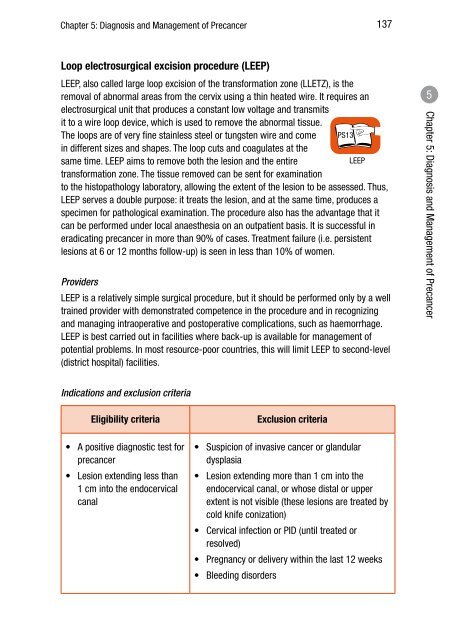CHAPTER 4: SCREENING FOR CERVICAL CANCER
CHAPTER 4: SCREENING FOR CERVICAL CANCER
CHAPTER 4: SCREENING FOR CERVICAL CANCER
Create successful ePaper yourself
Turn your PDF publications into a flip-book with our unique Google optimized e-Paper software.
Chapter 5: Diagnosis and Management of Precancer 137Loop electrosurgical excision procedure (LEEP)LEEP, also called large loop excision of the transformation zone (LLETZ), is theremoval of abnormal areas from the cervix using a thin heated wire. It requires anelectrosurgical unit that produces a constant low voltage and transmitsit to a wire loop device, which is used to remove the abnormal tissue.The loops are of very fine stainless steel or tungsten wire and come PS13in different sizes and shapes. The loop cuts and coagulates at thesame time. LEEP aims to remove both the lesion and the entireLEEPtransformation zone. The tissue removed can be sent for examinationto the histopathology laboratory, allowing the extent of the lesion to be assessed. Thus,LEEP serves a double purpose: it treats the lesion, and at the same time, produces aspecimen for pathological examination. The procedure also has the advantage that itcan be performed under local anaesthesia on an outpatient basis. It is successful ineradicating precancer in more than 90% of cases. Treatment failure (i.e. persistentlesions at 6 or 12 months follow-up) is seen in less than 10% of women.ProvidersLEEP is a relatively simple surgical procedure, but it should be performed only by a welltrained provider with demonstrated competence in the procedure and in recognizingand managing intraoperative and postoperative complications, such as haemorrhage.LEEP is best carried out in facilities where back-up is available for management ofpotential problems. In most resource-poor countries, this will limit LEEP to second-level(district hospital) facilities.5Chapter 5: Diagnosis and Management of PrecancerIndications and exclusion criteriaEligibility criteria• A positive diagnostic test forprecancer• Lesion extending less than1 cm into the endocervicalcanalExclusion criteria• Suspicion of invasive cancer or glandulardysplasia• Lesion extending more than 1 cm into theendocervical canal, or whose distal or upperextent is not visible (these lesions are treated bycold knife conization)• Cervical infection or PID (until treated orresolved)• Pregnancy or delivery within the last 12 weeks• Bleeding disorders
















